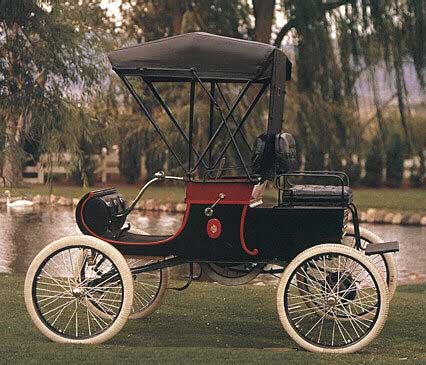Model R
Year: 1902-1903
Production in 1902: 2500 (approximate)
Production in 1903 - 3924 (approximate)
Serial Numbers in 1902 - 6425 thru 9999 (not sequential)
Serial Numbers in 1903 - 10000 thru 19999 (not sequential)
General
The 1902 Model R CDO is a continuation of the 1901 car with a brake installed inside the differential, somewhat ineffective, but making the car legal in France. Truss rods are fitted initially to the front and later to the rear axles and front & rear fenders added, maybe as an option. The body was all black except for the trim areas, painted a bright red. The red is more of a cherry color. Following a carefully study of several fairly original vehicles, the pin striping in the sketch is believed to be correct. The sketches show the design of the transmission band adjustment mechanism. An excellent picture of the chassis without a body is available and shows all the principle elements of the vehicle. At the time of production a continuing problem was the spring that connects the tiller to the steering arms. It failed several times on the cross country trip of Whitman and Hammond. It was changed yet again on the 1904 Model 6C.
Differences between 1902-03
There was a continuing effort by Oldsmobile to improve the CDO during 1902-03. For convenience, the CDO Club has given the Model R a suffix denoting the year it was built, however these must be considered as very flexible dates, we believe the changes were ongoing through the entire three year period. Thus the CDO for 1901 has been called the "R1" and the differences between it and the next two years were quite extensive. However the differences between R2 (1902) and R3 (1903) are much more subtle. The R2 had rubber bumpers which hold the body to the frame. The R3 body is bolted directly to the "L" brackets which are riveted on the out side of the frame rails. The R2 has a split in the rear frame member which formed a hole for the top of the chain to pass through. The R3 has a rear frame section which is bent upwards over the top of the chain, no hole. The R2 does not have fins on the lower cylinder block, while the R3 has large fins cast into the cylinder block. The R2 uses a centrifugal water pump coupled to the end of the crankshaft, while the R3 has the gear pump connected to the camshaft. The R2 has the "screw together" differential housing, (carried over from 1901) while the R3 has either a pressed or cast differential housing. The R2 uses block chain and the R3 conventional roller chain. The R2 has a fibre block to hold the timer spring and the R3 a brass frame. The R2 has a decompression lever mounted to brackets riveted to the frame while the R3 uses a compression release pedal the worked up and down like a plunger, bolted to the floor boards.
